long line fishing
- Thread starter warthog1981
- Start date
-
Hey Guest, Early bird pricing on the Summer Moot (29th July - 10th August) available until April 6th, we'd love you to come. PLEASE CLICK HERE to early bird price and get more information.
You are using an out of date browser. It may not display this or other websites correctly.
You should upgrade or use an alternative browser.
You should upgrade or use an alternative browser.
Because otherwise it is illegal ...den said:I take it you are on about fishing in the sea?
Hoodoo said:What is long line fishing?
I think it's primarily a sea fiching technique, where you let out a very long main line (up to eight miles) with short lines with hooks along it.
Environmentalists a few years ago touted it as being more acceptable than trawling with nets... but it turned out to be as bad in some cases.
Keith.
there are two sorts (or at least there two types of fishing referred two as long lining where i come from) one is to drag a long line several sets of feathers (20-50) behind a boat, i don't suppose thats the type your talking about...
the second is best described by a diagram

hooks can be set with lures or bait...
i have only ever done it on a small scale.. with some success..
the second is best described by a diagram

hooks can be set with lures or bait...
i have only ever done it on a small scale.. with some success..
One very good reason 'not' to use longlines 
European Cetacean Bycatch Campaign - Longlines Headlines
But perhaps you are referring to their use off beaches with rod and line warthog1981? Perhaps like the method Ray Mears used in the new series, by baiting hooks (he used thorns as hooks) in an estuary and leaving the line weighed down until the tide went out etc etc :?:

Read more here:CERTAIN species of albatross could be extinct within ten years unless fishing fleets change their practices, conservationists warned yesterday.
More than 100,000 birds each year are snared and drowned as they try to eat the bait from long lines of hooks towed by vessels, experts said.
European Cetacean Bycatch Campaign - Longlines Headlines
But perhaps you are referring to their use off beaches with rod and line warthog1981? Perhaps like the method Ray Mears used in the new series, by baiting hooks (he used thorns as hooks) in an estuary and leaving the line weighed down until the tide went out etc etc :?:
which kind of long line fishing is it which is dangerous to albatross.. i have never seen one in devon!
The kind that means there are no albatrosses in Devontomtom said:which kind of long line fishing is it which is dangerous to albatross.. i have never seen one in devon!
i always thought it was the version which has the line dragged behind a boat which was dengerous to sea birds as the hooks are pretty close to the surface!
Wotcher, Warthog.
Cor you ain,t half started something, be,looks.
Did you , perchance, mean the sort of long-lines that you stake out,usually from the beach, over a tide or two?
Used to call these "trot lines" around my bit of the coast, and the usual bait was a large welk, or somesuch.
Don,t rightly know if you can still do this, officially, from the shoreline, though, as kids, many did .
Maybe Ag and Fish could throw some light?
Do be sure, that you watch out for these Albatross, mind!
Seagull
Cor you ain,t half started something, be,looks.
Did you , perchance, mean the sort of long-lines that you stake out,usually from the beach, over a tide or two?
Used to call these "trot lines" around my bit of the coast, and the usual bait was a large welk, or somesuch.
Don,t rightly know if you can still do this, officially, from the shoreline, though, as kids, many did .
Maybe Ag and Fish could throw some light?
Do be sure, that you watch out for these Albatross, mind!
Seagull
I refer the Honourable gentleman to the answer I gave earlier....tomtom said:i always thought it was the version which has the line dragged behind a boat which was dengerous to sea birds as the hooks are pretty close to the surface!
From what I can see the problem is that sea birds scavenge off the back of boats including albatross, so no matter what method you use, they intercept the baits as they go into the water. Here is a clearer explanation (hopefully!):
This web site has better information including this quote and also gives solutions etc:Albatrosses and other seabirds often feed by scavenging for food behind fishing vessels and other boats, waiting for prey to be disturbed or scraps thrown overboard.
When longlining, fishing boats set thousands of baited hooks on a fishing line to catch fish. Seabirds scavenging behind these boats try to eat the bait from the hooks as they are set behind the boat. Some birds swallow the hooks and are dragged underwater and drown.
More than 300,000 seabirds are killed in this way each year. 26 species of seabird, including 17 species of albatrosses, are in danger of extinction because of the deaths caused by longlining.
Once set, the hooks are too deep for the birds to reach. To stop birds being needlessly killed, it is essential to stop them having the opportunity to swallow the baited hooks before they have sunk.
Birdlife International - Save the Albatross Campaign
back onto the original query, I think this might help clarify what we are talking about:
The person who set out the line is a 'Trotter'Trot lines are laid between the low and high water marks.
Long lines are set from boats beyond the low water mark.
The term has a slightkly different meaning and use in the USA:
This technique used in freshwater is illegal I understand in the UK as Adi said being a 'fixed engine' :?:WHAT IS A TROTLINE?
A trotline is a setline with multiple hooks that is employed in the open water of a lake or river by means of weights and floats. The number of hooks may vary from a half dozen to over a hundred, the latter being the sort used by commercial "longliners" in some southern states.
Generally, the hooks are set about 3 to 4 feet apart and attached to the main line by shorter lines called dropper lines or "trots." A swivel is used to attach the trots to the main line and this connection is called the "staging".
Limblines, throwlines, and juglines are variations on the same theme. A limbline is a trotline that's tied at one end to a limb or bush on the shore. It may have multiple hooks with a float and weight at the far end to hold the line out in the water. Or it may be a single baited hook dangling in the water. The important thing is that the limb must give. If you tie the line to a stout limb or tree or any object that doesn't flex/give, a big catfish, carp, or gar win pull loose, break the line, or straighten the hook. Weights on a trotline should not be too heavy, this is to prevent being pulled loose or breaking the line.
A throwline is simply a trotline that is baited up on shore and thrown out from the bank with a weight attached.
A jugline is typically a line tied to a single, floating, one gallon jug, which acts as a big bobber. The line may be weighted to the bottom and carries several hooks baited at different depths. Thus, while a "longline" type trotline fishes horizontally in the water, a jugline fishes vertically.
90% of the trotlines set in America are intended to catch catfish. In the minds of many anglers, trotlining is and always will be catfishing. The three major species are the channel catfish, blue catfish, and flathead catfish. At least one of these species is found in every state in the U.S. except for Alaska and Maine.
Cheers
Simon
There are 1000's in scotland and presumably they are around more rugged coastlines in the UK.The most common type of albatros I refer to is the Fulmer.You may not recognise it as an albatros as its only a small one, about the size of a herring gull.tomtom said:which kind of long line fishing is it which is dangerous to albatross.. i have never seen one in devon!
I have used a set up like this

When i was a kid i used to shoot a little trammel net but because i was only little it was nearly impossible for me to haul it due to to the number of dog fish i used to catch so my father made me some long lines.
Basically two ropes with an anchor and a buoy at each end and another rope strung between the two.
This rope was set at what ever height you wanted to fish at.
I had stainless "snoods" made up ,these where a stainless clip with a wire trace and a hook attached that you simply snapped in place anywhere along the main rope.
I had stainless clips on the main rope so i could adjust the height i fished at very easily.
I used to bait it with rag worm or fish and haul the line every day.
I found that the long lines caught less dog fish and more red gurnard and pollock than the net.
They worked very well and the method i used meant that the whole thing could be broken down and packed away easily unlike the versions where the hook lengths are fixed to the main line.
With the detachable snoods you can bait all your hooks at once and then just snap them on every couple of feet as you are feeding the main line over the side of the boat.
I never caught any gulls.
rb

When i was a kid i used to shoot a little trammel net but because i was only little it was nearly impossible for me to haul it due to to the number of dog fish i used to catch so my father made me some long lines.
Basically two ropes with an anchor and a buoy at each end and another rope strung between the two.
This rope was set at what ever height you wanted to fish at.
I had stainless "snoods" made up ,these where a stainless clip with a wire trace and a hook attached that you simply snapped in place anywhere along the main rope.
I had stainless clips on the main rope so i could adjust the height i fished at very easily.
I used to bait it with rag worm or fish and haul the line every day.
I found that the long lines caught less dog fish and more red gurnard and pollock than the net.
They worked very well and the method i used meant that the whole thing could be broken down and packed away easily unlike the versions where the hook lengths are fixed to the main line.
With the detachable snoods you can bait all your hooks at once and then just snap them on every couple of feet as you are feeding the main line over the side of the boat.
I never caught any gulls.
rb
You get fulmars in Devon TomTom, I saw one at Bucks Mill last year. I didn't know they were a type of albatross though. :biggthump Lovely straight wings and apparently if onebushwacker bob said:There are 1000's in scotland and presumably they are around more rugged coastlines in the UK.The most common type of albatros I refer to is the Fulmer.You may not recognise it as an albatros as its only a small one, about the size of a herring gull.
 on you it takes years to wash out and it stinks. :shock:
on you it takes years to wash out and it stinks. :shock:...And an albatross can circumnavigate the globe and return exactly to its nest. :super:
den said:I take it you are on about fishing in the sea?
yes i knew that it wasn't allowed in freash water
Sorry mate. Did i say that? :?:warthog1981 said:yes i knew that it wasn't allowed in freash water
Seagull said:Used to call these "trot lines" around my bit of the coast, and the usual bait was a large welk, or somesuch.
Don,t rightly know if you can still do this, officially, from the shoreline, though, as kids, many did .
Seagull
I used to do this off the Wirral coast. We called them lay-lines.
I still live on the Wirral coast and take my nephews on exercises like this. We walk out a couple of miles and set about thirty hooks staked between two poles in the sand. Usually do it accross a gully to bag a few plaice.
We return promptly after the tide's receded to gather our (usually very small!) catch!
The kids love it! It gets them out there in the fresh air - and gets them messy. It also educates them whilst having fun! It's not just about learning fishing technigue - it also teaches them respect for the sea and coastal environment, the dangers of tidal regions, safelty & awareness of their surroundings, safe and dangerous ground identification, etc etc.
Plus - I still get a blast out of it!!

I had a PM asking about the method i used so i dug out my old kit and took some pics and i hope they explain the system better.
First the anchor ,this is a home made anchor.
A rope is attached to the "tripping eye" and at the other end of the rope is attached the buoy.
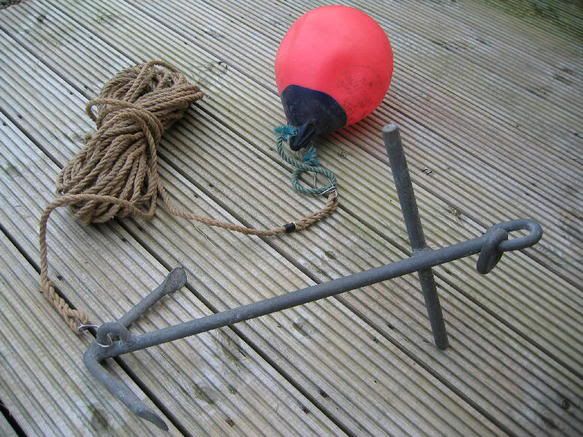
Another rope (the main line) is then attached to the anchor "ring".
The ropes are all the same length (approx. 70 feet) and have clip's at each end for quickly attaching and detaching.
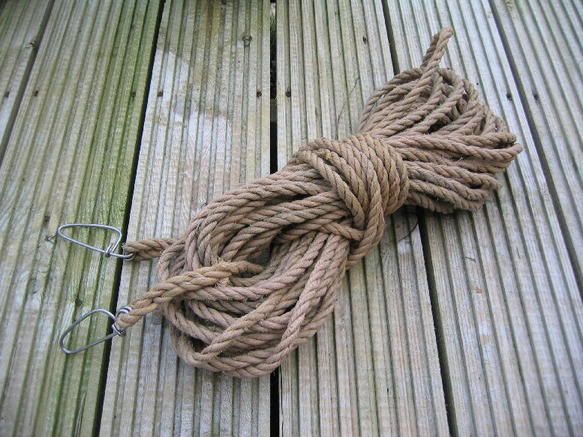
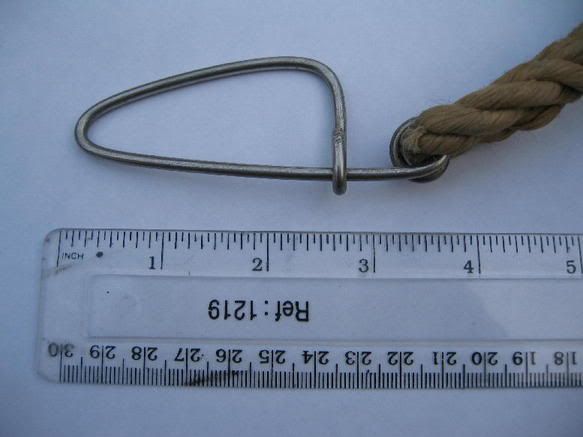
You "shoot" the line and when the anchor is on the bottom the boat will lie to it and you can begin to attach the "snoods" to the main line.
These are the snoods.
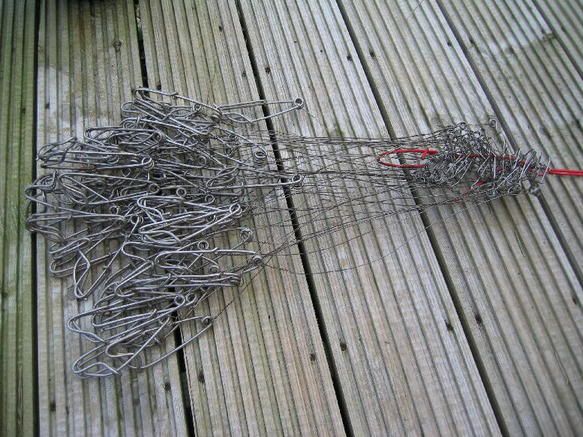
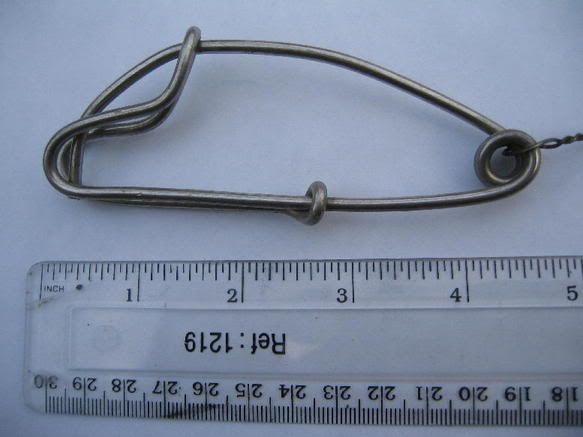
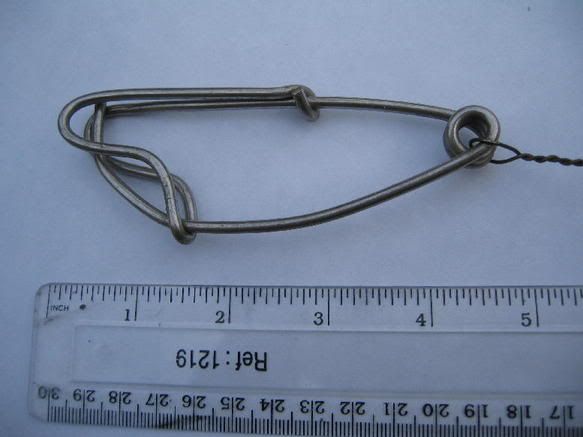
They are simply clipped in place.
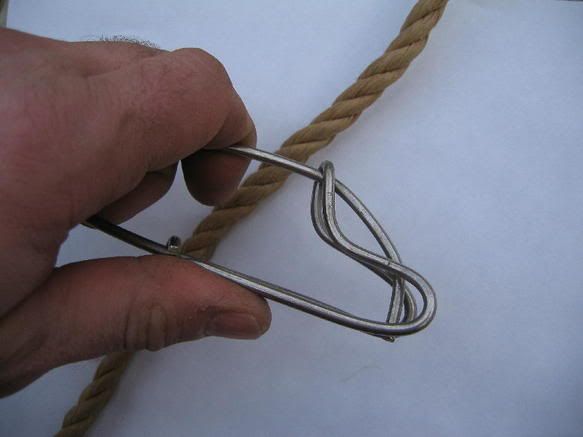
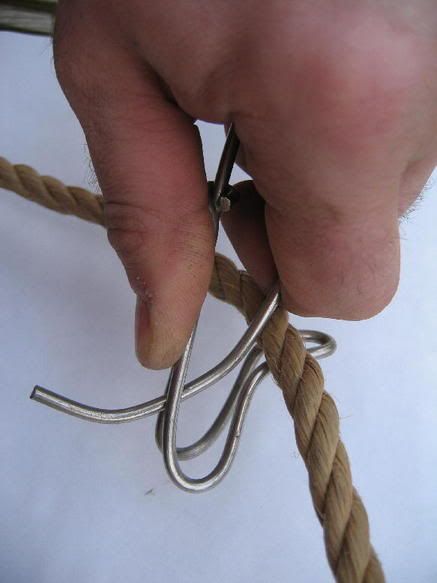
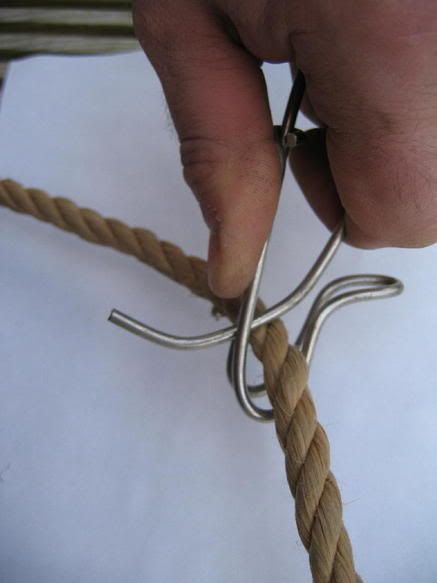
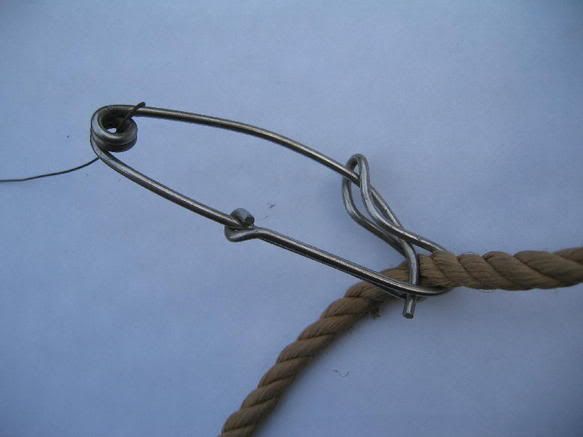
Attached to the snood is a "hook length" and to that is attached another clip.
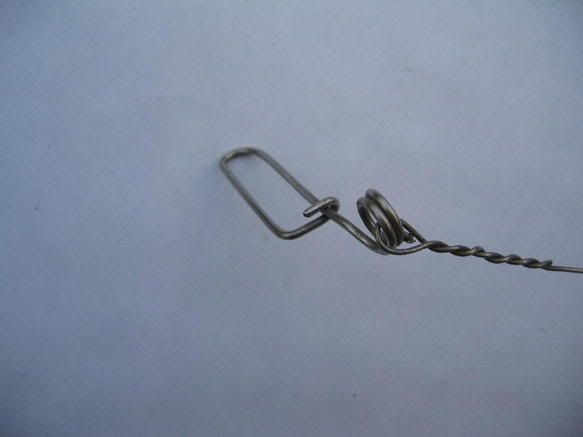
To this is attached a swivel and a hook.

As the main line is fed out the snoods are clipped on and spaced as required (best to clip far enough apart so the hooks can't tangle with each other).
As you come to the end of a rope simply snap on another untill you have used all the snoods.
Then attach to the ring of another anchor and attach another rope with a buoy to the tripping eye.
All the clips ,snood's and hook length's are all home made from stainless wire.
They are made on a jig so they are all the same size.
The clips are made larger than necessary so as to be easy to use when working with gloves on ,(very important as the rope's get covered in jelly fish stings)
Advantages over a normal mono filament long line setup are:
1.The snoods are all pre baited ,i used to bait them on the way out to the fishing grounds and this is much quicker than baiting each hook as it's fed out like on conventional mono long lines.
2.When you haul the lines you simply unclip the snoods ,complete with fish and drop them in a fish box rather than stopping to unhook them as you haul.
When you are heading home the fish can be unhooked and the swivel and hook can be dropped into a jar with some fish oil which will protect them until it's next needed.
Conventional long lines that leave the hook's attached need to have the hooks replaced as they corrode quickly in salt water.
The hooks in my pictures are 20 years old and as good as new.
3.You can coil the ropes as you haul them and when you reach a clip ,simply unclip and drop it in a basket.
This means you are actually packing the lines away as you haul them ,ready for the next time.
4.Being a modular system you can adapt it to suit ,increasing or decreasing th length of main line and the number of hooks to suit the ground and your requirements ,and any damaged parts are easily replaced.
5.Using ropes and large clips rather than mono and small snap swivels is much easier when wearing gloves and the whole system is much stronger and lasts much longer.
I hope this is clear but please ask any questions and i will do my best to explain.
rb
First the anchor ,this is a home made anchor.
A rope is attached to the "tripping eye" and at the other end of the rope is attached the buoy.

Another rope (the main line) is then attached to the anchor "ring".
The ropes are all the same length (approx. 70 feet) and have clip's at each end for quickly attaching and detaching.


You "shoot" the line and when the anchor is on the bottom the boat will lie to it and you can begin to attach the "snoods" to the main line.
These are the snoods.



They are simply clipped in place.




Attached to the snood is a "hook length" and to that is attached another clip.

To this is attached a swivel and a hook.

As the main line is fed out the snoods are clipped on and spaced as required (best to clip far enough apart so the hooks can't tangle with each other).
As you come to the end of a rope simply snap on another untill you have used all the snoods.
Then attach to the ring of another anchor and attach another rope with a buoy to the tripping eye.
All the clips ,snood's and hook length's are all home made from stainless wire.
They are made on a jig so they are all the same size.
The clips are made larger than necessary so as to be easy to use when working with gloves on ,(very important as the rope's get covered in jelly fish stings)
Advantages over a normal mono filament long line setup are:
1.The snoods are all pre baited ,i used to bait them on the way out to the fishing grounds and this is much quicker than baiting each hook as it's fed out like on conventional mono long lines.
2.When you haul the lines you simply unclip the snoods ,complete with fish and drop them in a fish box rather than stopping to unhook them as you haul.
When you are heading home the fish can be unhooked and the swivel and hook can be dropped into a jar with some fish oil which will protect them until it's next needed.
Conventional long lines that leave the hook's attached need to have the hooks replaced as they corrode quickly in salt water.
The hooks in my pictures are 20 years old and as good as new.
3.You can coil the ropes as you haul them and when you reach a clip ,simply unclip and drop it in a basket.
This means you are actually packing the lines away as you haul them ,ready for the next time.
4.Being a modular system you can adapt it to suit ,increasing or decreasing th length of main line and the number of hooks to suit the ground and your requirements ,and any damaged parts are easily replaced.
5.Using ropes and large clips rather than mono and small snap swivels is much easier when wearing gloves and the whole system is much stronger and lasts much longer.
I hope this is clear but please ask any questions and i will do my best to explain.
rb
Similar threads
- Replies
- 4
- Views
- 273
- Replies
- 0
- Views
- 92
- Replies
- 22
- Views
- 1K
- Replies
- 10
- Views
- 320
- Replies
- 4
- Views
- 205
